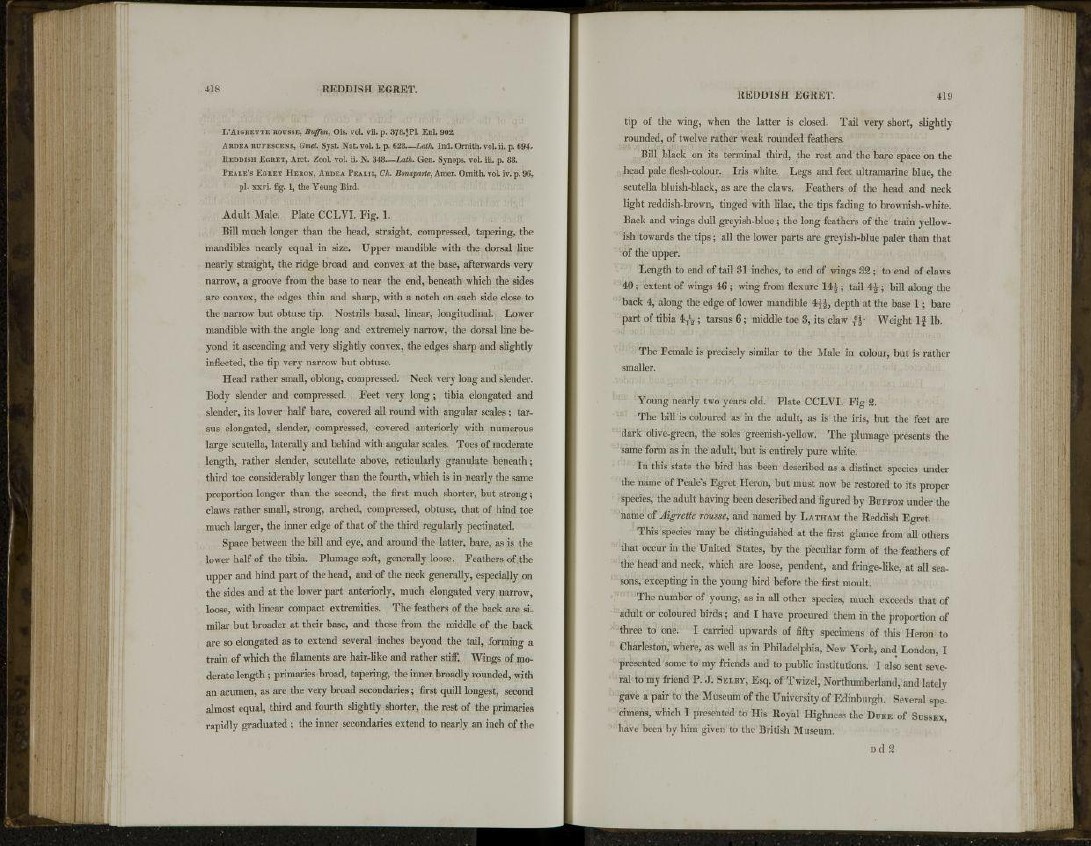
418 REDDISH EGRET.
L'AIGRETTE ROUSSE, Buffon, Ois. voL vii. p. 378.*P1. Enl. 902.
ARDEA RUFESCENS, Gmel. Syst. Nat. vol. i p. 628.—Lath. Ind. Ornith. vol. ii. p. 694.
REDDISH EGRET, Arct. Zool. vol. ii. N. 348.—Lath. Gen. Synops. vol. iii. p. 88.
PEALE'S EGRET HERON, ARDEA PEALII, Ch. Bonaparte, Amer. Ornith. vol. iv. p. 96,
pi. xxvi. fig. 1, the Young Bird.
Adult Male. Plate CCLVI. Fig. 1.
Bill much longer than the head, straight, compressed, tapering, the
mandibles nearly equal in size. Upper mandible with the dorsal line
nearly straight, the ridge broad and convex at the base, afterwards very
narrow, a groove from the base to near the end, beneath which the sides
are convex, the edges thin and sharp, with a notch on each side close to
the narrow but obtuse tip. Nostrils basal, linear, longitudinal. Lower
mandible with the angle long and extremely narrow, the dorsal h'ne beyond
it ascending and very slightly convex, the edges sharp and slightly
inflected, the tip very narrow but obtuse.
Head rather small, oblong, compressed. Neck very long and slender.
Body slender and compressed. Feet very long ; tibia elongated and
slender, its lower half bare, covered all round with angular scales ; tarsus
elongated, slender, compressed, covered anteriorly with numerous
large scutella, laterally and behind with angular scales. Toes of moderate
length, rather slender, scutellate above, reticularly granulate beneath;
third toe considerably longer than the fourth, which is in nearly the same
proportion longer than the second, the first much shorter, but strong;
claws rather small, strong, arched, compressed, obtuse, that of hind toe
much larger, the inner edge of that of the third regularly pectinated.
Space between the bill and eye, and around the latter, bare, as is the
lower half of the tibia. Plumage soft, generally loose. Feathers of the
upper and hind part of the head, and of the neck generally, especially on
the sides and at the lower part anteriorly, much elongated very narrow,
loose, with linear compact extremities. The feathers of the back are similar
but broader at their base, and those from the middle of the back
are so elongated as to extend several inches beyond the tail, forming a
train of which the filaments are hair-like and rather stiff. Wings of moderate
length ; primaries broad, tapering, the inner broadly rounded, with
an acumen, as are the very broad secondaries; first quill longest, second
almost equal, third and fourth slightly shorter, the rest of the primaries
rapidly graduated ; the inner secondaries extend to nearly an inch of the
R E D D I S H EGRET. 419
tip of the wing, when the latter is closed. Tail very short, slightly
rounded, of twelve rather weak rounded feathers.
Bill black on its terminal third, the rest and the bare space on the
head pale flesh-colour. Iris white. Legs and feet ultramarine blue, the
scutella bluish-black, as are the claws. Feathers of the head and neck
light reddish-brown, tinged with lilac, the tips fading to brownish-white.
Back and wings dull greyish-blue ; the long feathers of the train yellowish
towards the tips; all the lower parts are greyish-blue paler than that
of the upper.
Length to end of tail 31 inches, to end of wings 32 ; to end of claws
40; extent of wings 46 ; wing from flexure 14^ ; tail 4^ ; bill along the
back 4, along the edge of lower mandible 4<\\, depth at the base 1 ; bare
part of tibia 4T^ ; tarsus 6; middle toe 3, its claw ^J- Weight I f lb.
The Female is precisely similar to the Male in colour, but is rather
smaller.
Young nearly two years old. Plate CCLVI. Fig 2.
The bill is coloured as in the adult, as is the iris, but the feet are
dark olive-green, the soles greenish-yellow. The plumage presents the
same form as in the adult, but is entirely pure white.
In this state the bird has been described as a distinct species under
the name of Peale's Egret Heron, but must now be restored to its proper
species, the adult having been described and figured by BUFFON under the
name of Aigrette rousse, and named by LATHAM the Reddish Egret.
This species may be distinguished at the first glance from all others
that occur in the United States, by the peculiar form of the feathers of
the head and neck, which are loose, pendent, and fringe-like, at all seasons,
excepting in the young bird before the first moult.
The number of young, as in all other species, much exceeds that of
adult or coloured birds; and I have procured them in the proportion of
three to one. I carried upwards of fifty specimens of this Heron to
Charleston, where, as well as in Philadelphia, New York, and London, I
presented some to my friends and to public institutions. I also sent several
to my friend P. J. SELBY, Esq. of Twizel, Northumberland, and lately
gave a pair to the Museum of the University of Edinburgh. Several specimens,
which I presented to His Royal Highness the DUKE of SUSSEX,
have been by him given to the British Museum.
D(l 2